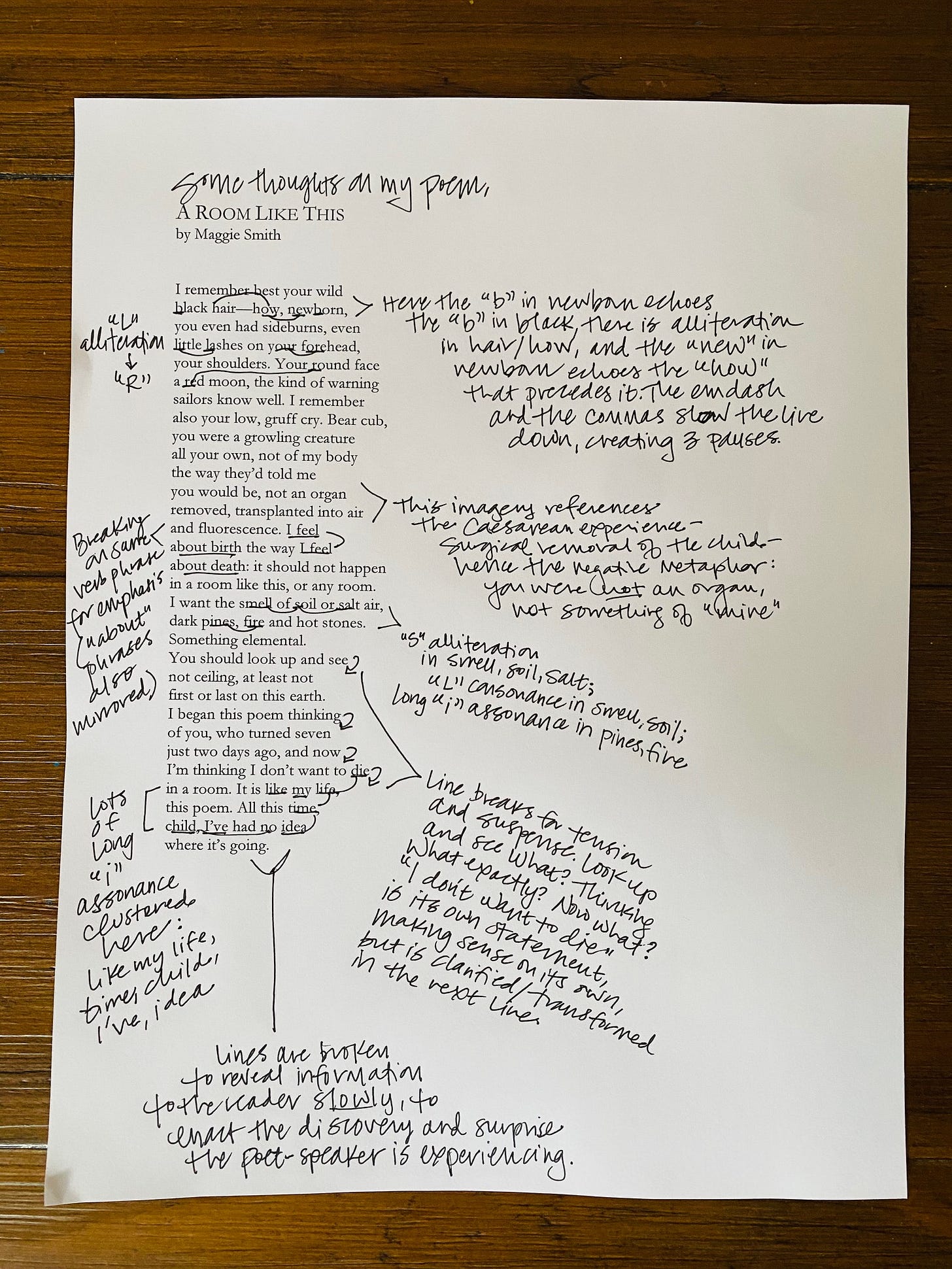Hi, Friend.
Let’s talk about pacing in a poem. Where do you want to encourage the reader to slow down or pause and reflect? And how?
There many ways to slow a poem down: incorporating white space, shortening the lines, using commas within sentences for pauses. (Conversely, to speed a poem up, you might remove white space, lengthen the lines, and streamline the sentences.)
In “A Room Like This,” the short lines are somewhat offset by the lack of white space (no stanza divisions). One choice encourages the reader to slow down, while the other creates momentum without “breathing room” between lines. I think commas and sentence length do the most work to slow the poem down. There is only one sentence—a fragment, really—that does not include any commas: “Something elemental.” Every other sentence in the poem has at least one, and many have several.
The opening five lines of the poem alternate between enjambed and end-stopped lines. (Lines with enjambment don’t end with punctuation; end-stopped lines do, creating longer, more dramatic pauses.)
I remember best your wild
black hair—how, newborn,
you even had sideburns, even
little lashes on your forehead,
your shoulders. Your round face
The closing five lines are a mix of enjambed and end-stopped lines, too, but you can hear the difference in the pacing.
I’m thinking I don’t want to die
in a room. It is like my life,
this poem. All this time,
child, I’ve had no idea
where it’s going.
The opening is a single sentence, plus the beginning of a new one, while the closing is made up of shorter sentences with more internal punctuation. The multiple commas and short sentences slow the poem down. I often want to slow down the end of a poem, so the reader can pause and absorb the landing. I don’t want to rush the last move.
Looking at the poem again, I see that “newborn” offset by commas in the opening mirrors “child” offset by commas in the closing. Those commas force a pause before and after those meaningful words; I think of the commas as cushioning those words with air.
My two cents: Test out many different options for your poem—different line lengths, stanza shapes, sentence structures, word choices—and read those variations aloud. You’ll hear the places where you want to build in pauses; you’ll hear where the poem could use another phrase or beat, or where you want to streamline the poem by cutting syllables or simplifying the syntax.
I’m a broken record about this, I know, but I believe it wholeheartedly. Read aloud as you go. Listen to the poem.
Happy writing—
Maggie




I’ve thought a bit more about what you shared with us here re pacing and commas/punctuation etc.—thank you for these details and insights. I then revisited the poem and read it aloud to myself a few times. I used to read poems aloud to myself more regularly, to both slow down and connect with the poem more deeply, meaning, to literally listen to it speak. I will pick up again with this way of reading/listening—it is a kind of mediation practice for me in a way.
Overall, your piece/offering reminded me that yes, listening to a poem is such an important piece of the process of discovery/writing/crafting/constructing/refining etc., and it also reminded me of a great line of W.S. Merwin’s that I think about often, that “poetry begins and ends with listening.” Indeed, it does.
When we read aloud (again, at least for me), there is a heightened sense of presence and connection, along with a grounding or centeredness, even a tethering perhaps—holding on to a kite comes to mind—which often allows us to wander around with and within the poem, to join in and/or enter the journey of feeling/thought/memory/image/language etc. Pacing is an essential tool (a control/frame/steady guide etc.) that leads us through the experience of the poem. I really appreciated your idea of using pacing as a way to create “breathing room.”Also loved your line of thought that you “think of the commas as cushioning those words with air.”
Perhaps, in a future ‘craft tip’ post (if it is not already on your list), I would love to read about your thinking/approach to spacing and/or the use of white space on the page etc., particularly in your poems “Threshold” and/or “Invisible Architecture”, or any other. Really appreciated this post—great food for thought and writing—thank you! 🔅🔆
I love the way a poem changes when you change the line-breaks and lengths. Sometimes I make so many variations that more than one work, and I’ve created two poems, and I have trouble choosing one! Time eventually tells me which is better. And of course, listening closely when I read aloud. I love these pacing craft tips -- they help me teach my 9th grade poetry students, too!